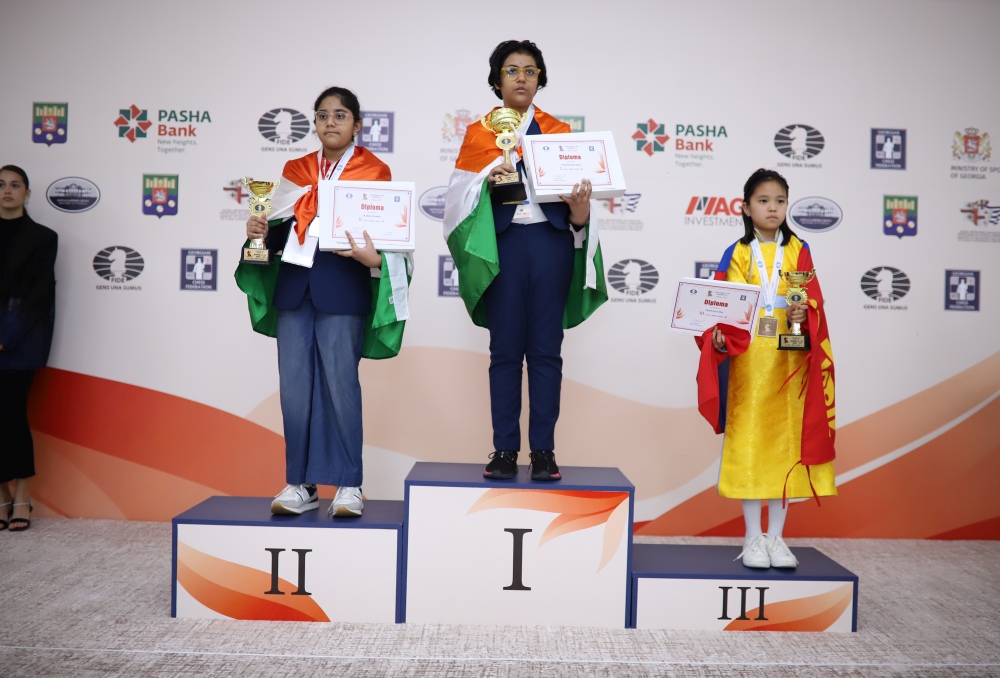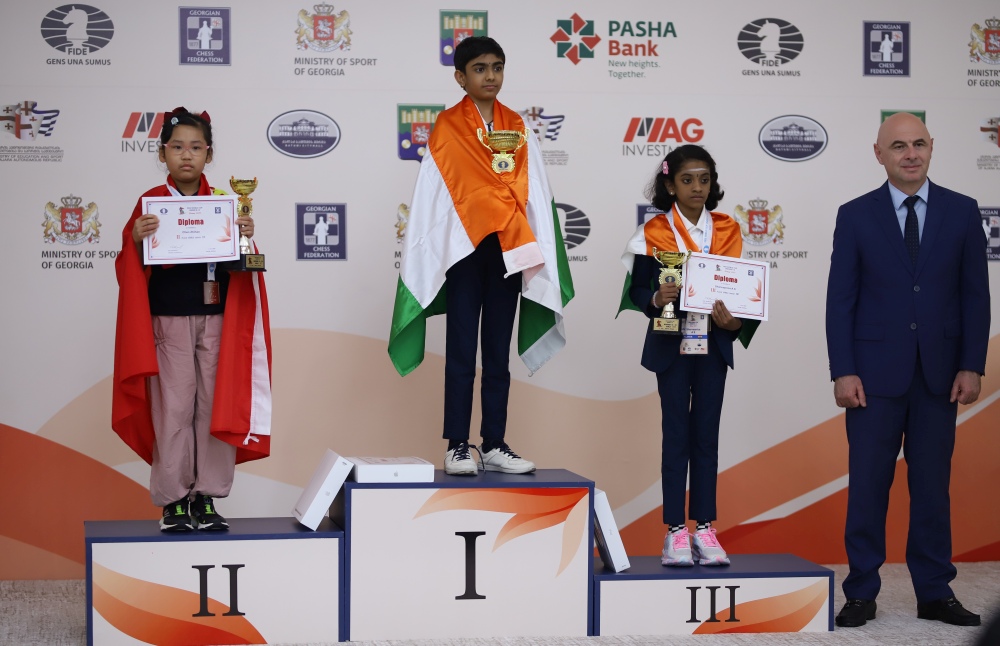
2nd place: Dowda Aadya (India)
3rd place: Ider Tselmuun (Mongolia). Image: FIDE.Com
Talk about Indian chess revolves mostly around the top of the pyramid. Three in the world’s first six, D Gukesh beating Magnus Carlsen in classical and rapid in quick succession, R Praggnanandhaa’s bull run — they have swung the world’s attention towards them for valid reasons. Everybody asks, what caused this, other than the influence of Viswanathan Anand?
A look at the FIDE World Cup in the under 8, 10 and 12 segments provides the answer. There were open and girls categories in each section in the event played in Batumi in Georgia. Of the 18 medals on offer, Indians claimed seven. Sarbartho Mani (open, U-10), Brijesh Divi (girls, U-10) and Pratitee Bordoloi (girls, U-12) struck gold. Their teammates bagged two silver and bronze each to make India the most successful team in terms of medals won by a distance.
Had the base not been this strong and wide, the top would not have taken the world by storm. In Bantumi, there was an Indian clean sweep in open U-10, one-two in girls U-12 and gold-bronze in girls U-10. This dominance in this cadet-level tournament held in a country with one of the richest traditions of chess answers that oft-asked question. It also explains why the world U-19 champions — Pranav Venkatesh and Divya Deshmukh — hail from the same system.
“There’s a reason why we have a player who became the world champion at 18,” Pravin Thipsay told RevSportz. “There’s stiff competition from the age group of eight. There are many playing seriously. They’re almost like professionals. I mean, they don’t earn because there isn’t a lot of prize money. But for the children and their parents, travel and training fees make it a professional commitment,” said Thipsay, who became India’s third Grandmaster in 1997. The country has 85 now.
Associated with grassroots coaching for a long time, Thipsay has travelled with cadet, junior and senior teams. “We have a class which is very serious about children emerging champions. They are willing to take them wherever they want and spend. We see good results because of this hard work and sacrifices. Coaches and other systems play a smaller part,” said the 65-year-old.
Also Read: Soumen Majumdar: India’s first and only star organiser of chess events

2nd place: Zhihan Chen (China)
3rd place: Sharvaanica A S (India). Image: FIDE.Com
Probe him a bit and the first Indian to secure a GM norm admits that the standard of coaching has improved leaps and bounds and this has made a telling difference. A number of GMs have turned to coaching across the levels and children have access to them. Dibyendu Barua, India’s second GM, is another example. He runs an academy where enrolment starts from the age of eight.
“Earlier also, there were coaches,” Thipsay said. “But not so many GMs as coaches. It shows that they cannot make money playing. That’s why GMs rated 2600-2650 are into this. This also means there is expertise available for players at a very young age. The GMs have gone through the path of difficult learning. When they teach, it’s advantageous for the children because they won’t spend so much time learning. Whatever knowledge we acquired, in 40, 30 or 20 years, is imparted to the children very quickly,” said Thipsay, who also attributes this rapid rise to the proliferation of online coaching.
This ‘theory of quick learning’ is validated by facts. Of the three Indians making waves at the elite level, the oldest is 21. Players from the country won medals from junior events in the past also, but not with this kind of consistency. If there are bunch of runaway winners at the lowest rung, the probability of at least some of them making it big at the senior level increases. The heist of Georgia is the latest example of that process unfolding at a rapid pace.
Follow RevSportz For More Articles From Chess



